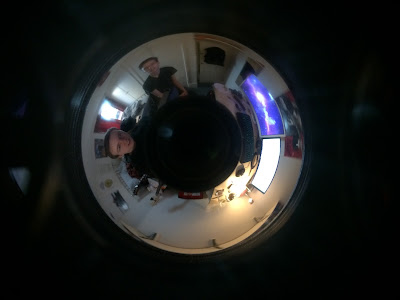Tuesday, 23 February 2016
360 Animation Tests
To further work out our production pipeline we decided to play around with using my 360 phone rig to do some very basic stop motion animation and to see if we could cut out green-screen elements and replace them with other components in Nuke and then wrap the video back up and view it in YouTube's 360 video viewer. Below is the final cut of that test.
After this test worked very successfully I had to make an animated camera version in Maya like I did in the Last test with the still image except this time using the animated video. Below is the result of this test.
Below is the unwrapped version of this video so you can see what it looks like for us to edit in Nuke and Adobe Premiere, as well as a couple of photos of what the set looked like and the phone camera lens.
360 Animation Ideas
For my third year film George and I have had an idea to do 360 degree stop motion animation. This immediately threw up many pipeline issues, however as far as we can see no one else has done it, and we can see why. We are thinking of using my 1 sheet pitch as our story basis and so we will need to be able to cut green-screen elements out and composite in some 3D rendered objects. first things first, we needed to be able to shoot basic stop motion in 360 degrees. I bought a very cheep 360 lens that fits on my phone and started playing with that.
Above is the raw picture that this lens takes, from there we had to unwrap it and then work out how to view it in 360.
Above is what this picture looks like when we unwrap it in a very simple program called 0-360. from here we applied this to a cylinder in Autodesk Maya and animating the camera as a way of veiwing it in 360. below is the result of that test.
Above is the raw picture that this lens takes, from there we had to unwrap it and then work out how to view it in 360.
Above is what this picture looks like when we unwrap it in a very simple program called 0-360. from here we applied this to a cylinder in Autodesk Maya and animating the camera as a way of veiwing it in 360. below is the result of that test.
Monday, 22 February 2016
Jump Animation
I did this animation over the weekend and I am very happy with the way it turned out, I drew out some thumbnail drawings and then put those in flash to get the timing right and then drew over those to get the key-frames and then drew the motion curves for the head and both hands to make sure the inbetweens would be smooth and make sense. I think he spends a bit too long in the air in the middle of the jump but other than that I am very happy with how smooth it is.
1 Sheet Pitch
Last week we had guest lecturer Luis Cook in to help us generate ideas and show us how to pitch and do a 1 sheet pitch, this is the basic idea i had which i am considering taking to the third year and the picture above is the 1 sheet that i pitched to Luis Cook. I got a lot of great feedback on it and this idea has already evolved a huge amount and is almost unrecognizable.
Second Bifrost Test
Listening Project Animatic
Bifrost Water Tests
Fun Animation Time
Subscribe to:
Comments (Atom)





